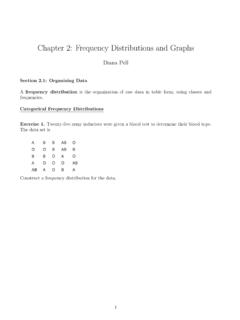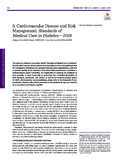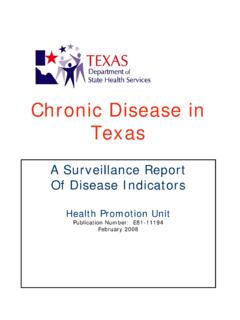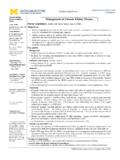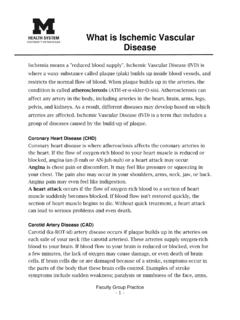Transcription of CARDIOVASCULAR DISEASE, DIABETES, AND CHRONIC …
1 CARDIOVASCULAR disease , DIABETES, AND CHRONIC LUNG DISEASESC hapter 14 Copyright 2015 McGraw-Hill Education. All rights reserved. No reproduction or distribution without the prior written consent of McGraw-Hill disease CARDIOVASCULAR disease (CVD): any disease involving the heart and/or blood vessels Currently the leading cause of death in the United States, accounting for one-third of all deaths CVD is a general term for diseases that include heart attack, stroke, peripheral artery disease , congestive failure, and others The disease process underlying many forms of CVD is atherosclerosis, or hardening of the arteriesCopyright 2015 McGraw-Hill Education.
2 All rights reserved. No reproduction or distribution without the prior written consent of McGraw-Hill from Types of CVD in the , 2013 Copyright 2015 McGraw-Hill Education. All rights reserved. No reproduction or distribution without the prior written consent of McGraw-Hill A common form of arteriosclerosis that involves a thickening or hardening of the arteries due to the buildup of fats and other substances Starts with damage to the inner lining of vessels and the formation of a fatty streak accumulation of lipoproteins within the walls of an artery Once an injury exists on the artery, white blood cells, collagen, and other proteins are formed.
3 Creating plaque (accumulation of debris in an artery wall) Results in slow blood flow, reducing the amount of blood to the tissues Plaque can break off and completely block arteryCopyright 2015 McGraw-Hill Education. All rights reserved. No reproduction or distribution without the prior written consent of McGraw-Hill 2015 McGraw-Hill Education. All rights reserved. No reproduction or distribution without the prior written consent of McGraw-Hill Heart disease and Heart Attack Coronary heart disease (CHD): atherosclerosis of the coronary arteries, which can result in a heart attack CHD is the leading form of all CARDIOVASCULAR diseases An estimated million Americans are living with CHD Those who survive a heart attack are often left with damaged hearts and significantly altered livesCopyright 2015 McGraw-Hill Education.
4 All rights reserved. No reproduction or distribution without the prior written consent of McGraw-Hill Heart disease and Heart Attack Ischemia: insufficient supply of oxygen and nutrients to tissue, caused by narrowed or blocked arteries Myocardial infarction: lack of blood flow to the heart muscle with resulting death of heart tissue, often called a heart attack Coronary thrombosis: blockage of a coronary artery by a blood clot that may cause sudden death Angina: pain, pressure, heaviness, or tightness in the center of the chest caused by a narrowed coronary arteryCopyright 2015 McGraw-Hill Education.
5 All rights reserved. No reproduction or distribution without the prior written consent of McGraw-Hill and Sudden Cardiac Death Arrhythmia: irregular or disorganized heartbeat Normal adult heart rate is 60 100 beats/minute Ventricular fibrillation: type of arrhythmia in which the ventricles contract rapidly and erratically, causing the heart to quiver or tremor rather than beat Sudden cardiac death: abrupt loss of heart function caused by an irregular or ineffective heartbeatCopyright 2015 McGraw-Hill Education.
6 All rights reserved. No reproduction or distribution without the prior written consent of McGraw-Hill A strokeor cerebrovascular accident (CVA) occurs when blood flow to the brain or part of the brain is blocked Fourth leading cause of death in the United States; leading cause of severe, long-term disability Ischemic stroke: caused by blockage in a blood vessel in the brain (accounts for 87% of all strokes) Thrombus Embolism Hemorrhagic stroke: caused by rupture of a blood vessel in the brain, with bleeding into brain tissue Transient ischemic attacks (TIAs) ministrokes ; periods of restricted blood supply that produce the same symptoms as a strokeCopyright 2015 McGraw-Hill Education.
7 All rights reserved. No reproduction or distribution without the prior written consent of McGraw-Hill Heart Failure Condition in which the heart is not pumping the blood as well as it should, allowing blood and fluids to back up in the lungs Can develop after a heart attack or as a result of hypertension, heart valve abnormality, or disease of the heart muscle Person with this condition experiences difficulty breathing, shortness of breath, coughing, fatigue, and confusionCopyright 2015 McGraw-Hill Education.
8 All rights reserved. No reproduction or distribution without the prior written consent of McGraw-Hill CARDIOVASCULAR Diseases Heart valve disorders Most common is the mitral valve prolapse Congenital heart disease Structural defect at birth Peripheral vascular disease (PVD) Atherosclerosis in the arms and legs Cardiomyopathy disease of the heart muscle Dilated HypertrophicCopyright 2015 McGraw-Hill Education. All rights reserved. No reproduction or distribution without the prior written consent of McGraw-Hill Controllable Factors in CARDIOVASCULAR Health Tobacco use Blood pressure levels Cholesterol levels Physical activity BMI Blood glucose levels DietCopyright 2015 McGraw-Hill Education.
9 All rights reserved. No reproduction or distribution without the prior written consent of McGraw-Hill Pressure Force exerted by blood against artery walls Determined by two forces: Pressure when the heart contracts (systolic; top number) Pressure in the arteries when the heart is relaxed (diastolic; bottom number) Hypertension: blood pressure that is forceful enough to damage artery walls Untreated high blood pressure/hypertension: Can weaken and scar the arteries and make the heart work harder Can cause heart attacks, strokes, kidney disease , peripheral artery disease , and blindnessCopyright 2015 McGraw-Hill Education.
10 All rights reserved. No reproduction or distribution without the prior written consent of McGraw-Hill 2015 McGraw-Hill Education. All rights reserved. No reproduction or distribution without the prior written consent of McGraw-Hill 2015 McGraw-Hill Education. All rights reserved. No reproduction or distribution without the prior written consent of McGraw-Hill Factors in CARDIOVASCULAR Health Triglyceride levels Levels of these blood fats should be less than 150 to achieve desired levels Alcohol intake Heavy drinking (more than 3 drinks/day) can damage the heart Light drinking (less than 2 drinks/day)




